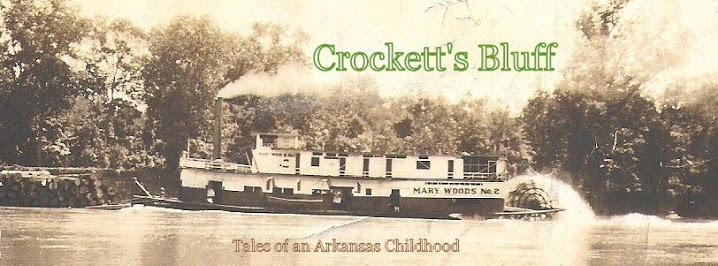The Prange Brothers Water Tower
1930s
|
When the Prange Brothers established a water tower in the late 1920s or early '30s apparently to insure fire protection for the nearby warehouses they had constructed overlooking the bluffs of the White River for which Crockett's Bluff was named, it became the trademark for the then lively settlement for at least the next fifty years. Visible clearly from more than five miles southward where Rt 153 intersected Rt 1 - known informally in the 1950s as Boyd's Corner - it dominated the skyline. There was nothing to equal it for many miles. Legend has it one who climbed to its circular balcony joined a relatively small group of folks adventurous and courageous enough to make the climb.
The oldest known images that survive - published first in David Prange's Crockett's Bluff As I Remember It - were made from its walkway platform by his cousin Louis Prange in 1930. "It stood as if a sentinel," writes David, "watching over the village of Crockett's Bluff, giving direction to those searching for the village while, at the same time, nurturing the two mammoth steam engines which powered the pumps that lifted water from the river onto the rice fields of the White River prairie."
These images were posted elsewhere on this site several years ago: Crockett's Bluff: A 1930s View From Above.
In his memoir David Prange goes on to describe the bravery required and the rite of passage acknowledged by those managing to make it to the top of the water tower, approximately one hundred feet above grade. "I envied those that accomplished that feat, not for their bravery, which I considered to be bordering on stupidity, but for the view they had witnessed. What a magnificent sight that must have been." Successful adventurers were plied with questions: "Could you see beyond the north bend in the river? . . . Could you see Voss Lake? . . . With each 'yes' I would think, without daring to repeat the thought audibly, 'It's not possible, I don't believe it!"
For reasons that are not clear, a decision was made by August Prange, the last descendant to remain on the property, to dismantle the tower sometime in the late 1970s or early 80s. So, we are left with these images.
The most noteworthy view that I've come across (above) that follows those made by Louis Prange was made by Eddie Schwab himself of his store and the area around it - the Prange store in the foreground and the gardens and out buildings, including the blacksmith forge shed of his father Sebastian Schwab and the gardens and field beyond.
Like so many other images on this site I have Jim Prange to thank for this view of the area behind the Schwab store also obviously made from the water tower by an unknown photographer he gleaned from his family collection. Both Vickie (Schwab) Gardner and Peggy (Schwab) Browning have memories of residing in the small cottage at the left during the early days of their marriages.
These images were posted elsewhere on this site several years ago: Crockett's Bluff: A 1930s View From Above.
 |
| View to the North along the River. |
Looking north shows a relatively flourishing community on the banks of the White River: the Prange sawmill, the Lutheran church, and the Poole store.
 |
| View to the South out toward the prairie. |
On the right Schwab's Store and the wagon shed, and on the left the Inman store and, most significant, the irrigation canal that extended out across the prairie and the rice fields and served as a "swimming hole" for every child in the Bluff well up into the 1960s and 70s. It was where we learned to swim.
For reasons that are not clear, a decision was made by August Prange, the last descendant to remain on the property, to dismantle the tower sometime in the late 1970s or early 80s. So, we are left with these images.
Like so many other images on this site I have Jim Prange to thank for this view of the area behind the Schwab store also obviously made from the water tower by an unknown photographer he gleaned from his family collection. Both Vickie (Schwab) Gardner and Peggy (Schwab) Browning have memories of residing in the small cottage at the left during the early days of their marriages.
 |
| Jim Prange as a wee lad in the l950s in the area above |
 |
| Scan of a dusty slide I made in the 1970s |



